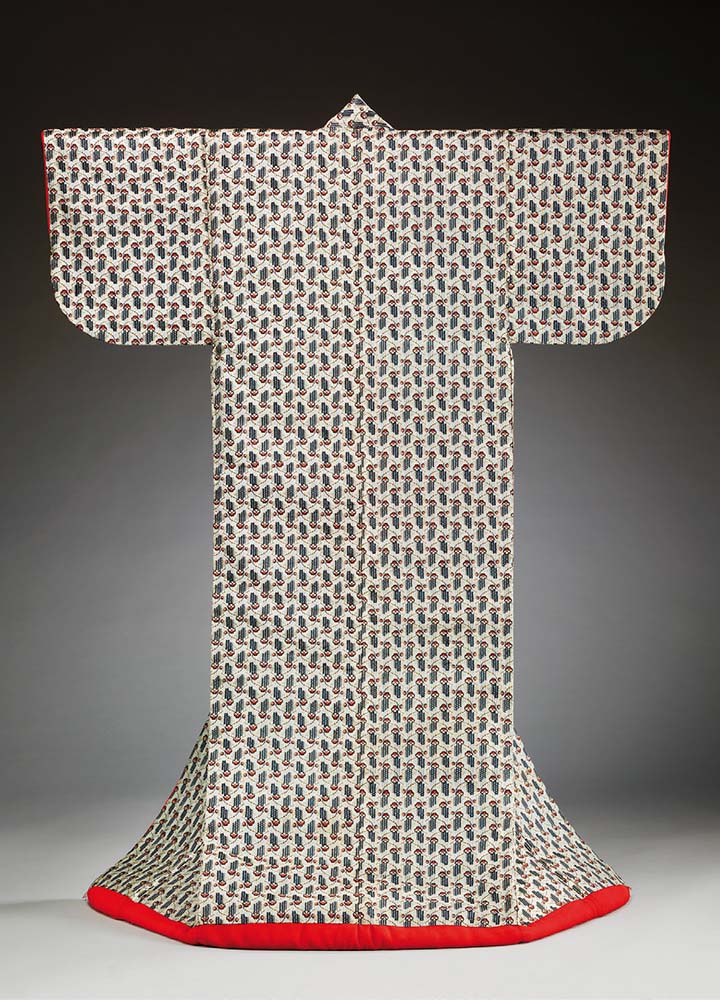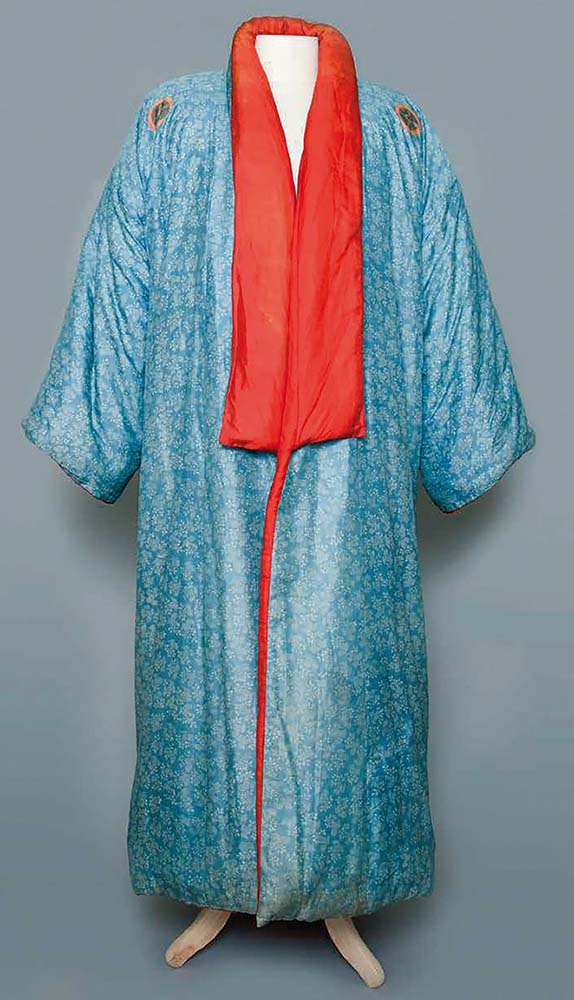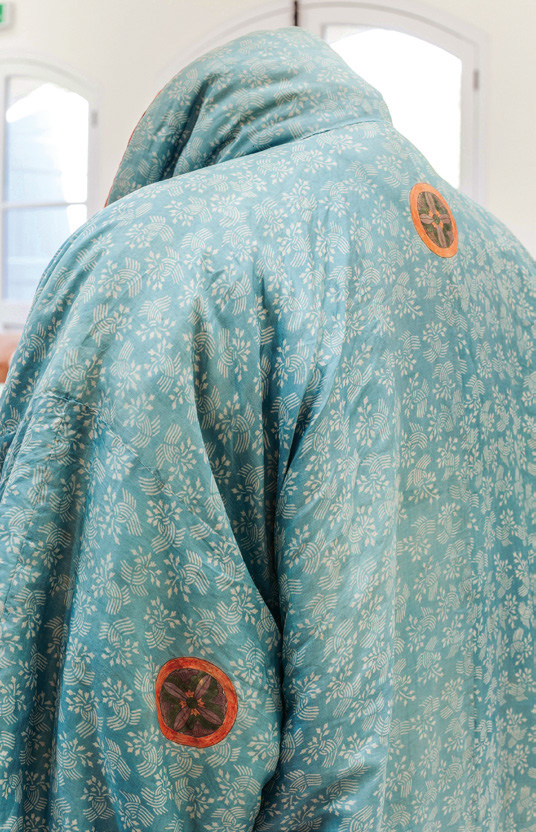A Tale of Two Silks
The Victoria and Albert Museum in London has one of the most significant collections of Japanese textiles and dress in Europe. One recent acquisition is an Edo-period (1615-1868) outer kimono (uchikake) [fig. 1]. What makes the garment so unusual is that it is made from silk brocade woven in Lyon in the mid-18th century. Such fabric was typically used to make suits for stylish and wealthy European men. Instead, this silk found its way to Japan, where it was made into a kimono for a high-ranking woman from Japan’s ruling military (samurai) class.

Fig 1: Outer kimono for a woman (uchikake). Fabric woven in Lyon, France, 1750–70; tailored in Japan, 1750–1850. Brocade silk. Given by Yoshida Kōjirō. © Victoria and Albert Museum.
Lyon was the main centre for silk weaving in France from the late 17th century, and here Europe’s most fashionable fabrics were designed and manufactured. The marketing and distribution of Lyonnais silk was carried out by commissionaires who would travel widely through Europe, carrying samples with which to demonstrate both the high quality and the innovative designs of the forthcoming seasonal collections. As socially adept as they were commercially skilled, these dedicated salesmen would cultivate a rich clientele in major cities such as Amsterdam. It was presumably here that an order was placed for a roll of silk with a small-scale pattern in blue, pink, yellow, and black on a white ground, perhaps by a leading member of the Dutch East India Company (Vereenigde Oostindische Compagnie or VOC) [fig. 2]. Whether the silk was originally purchased to tailor domestic garments or specifically to take to Asia is not known, but such an expensive item would certainly not have been left unused. So, soon after its creation in Lyon, it was placed on a VOC ship bound for Japan.

Fig 2: Detail of outer kimono for a woman (uchikake). Given by Yoshida Kōjirō. © Victoria and Albert Museum.
Japan severely restricted foreign trade and relations during most of the Edo period. The Dutch were, however, permitted to maintain a trading base on Dejima, a small artificial island in Nagasaki harbour. Their movements and activities were heavily constrained, but the Dutch were accorded the honour of regular audiences with the shōgun. Once a year, the VOC chief, secretary, and physician would make the long journey to Edo to pay their respects, present gifts, and give thanks for the continuation of trade. Cloth was a major commercial commodity as well as an important article of diplomatic exchange, and the fabrics the Dutch brought to Japan aroused great interest. In the 17th century, Chinese and Bengali silks pre-dominated, but there was then a major shift to cottons from South and Southeast Asia. The latter became highly fashionable and there are a number of extant kimono made from imported cotton. The V&A’s uchikake is, as yet, the only known Edo-period garment to be made from European silk. Given its high quality, the fabric was certainly a diplomatic gift. Testimony from the private collector who donated the kimono to the museum revealed that the garment had probably belonged to the wife of the Nabeshima daimyō, who ruled the Saga domain in south-east Japan. The domain was largely responsible for the military defence of nearby Nagasaki. It also had strong links with Dutch trade: the export porcelain centre of Arita and the port of Imari, from which the pottery was shipped, were both located in Saga. The Dutch party also passed through Hizen, the castle town, on their journey to Edo. It is not known whether the French fabric was a gift that resulted from this close connection or whether it came to Nabeshima via the shogunate, nor indeed when it was made into a garment. What is clear is that wearing a kimono of such rare and exotic cloth would have been an indicator of both status and style.

Fig 4: Night gown (Japonse Rock), Japan, 1700–20. Plain weave silk, stencil dyeing (katazome). © National Trust for Scotland, Newhailes.
The uchikake was featured in the V&A exhibition Kimono: Kyoto to Catwalk, staged in 2020, in the section that explored the sartorial interaction between Japan and Europe in the Edo period [fig. 3]. Also displayed was a recently discovered robe of Japanese indigo-dyed plain weave silk (habutae) worn in Britain in the early 18th century [fig. 4].

Fig 5: Detail of Night gown (Japonse Rock). © National Trust for Scotland, Newhailes.
Just as the Dutch gifted cloth, they were presented with kimono. Engelbert Kaempfer (1651-1716), doctor at the VOC base in Dejima from 1690-1692, recorded the garments that the Dutch received when they travelled to Edo. On his second visit to the capital, Kaempfer reported that “on the 25th of April, we had 10 fine gowns sent to us by Bingo, 5 as good as any wove with flowers, by the young Prince of Firando [Hirado], ... and a couple of sorry ones by the second Governor of Jedo [Edo].” Together with those given by the shōgun, Kaempfer noted that a total of 123 garments were received on this occasion. The Dutch shipped the kimono they received to the VOC headquarters in Batavia, and from there to the Netherlands, where they fetched high prices at the East India Company’s auctions.
A style of loose robe was already part of the European wardrobe, being worn for informal gatherings or to provide extra warmth for the scholar in his library. However, the arrival of Japanese silk garments with their colourful patterning and lightweight wadding between exterior fabric and lining caused a great stir. To capitalise on the vogue, the Dutch began to commission a particular style of kimono from Japanese makers which had modified, more tubular sleeves and a thick silk wadding. For someone living in the chilly environs of northern Europe these Japonse Rock, as they were known, were wonderfully warm as well as luxurious and fashionable. They are mostly associated with male dress but were also worn by women.
Only a few of the Japan-made garments survive, and most are in the Netherlands. Recently, however, one has been found in the collection of Newhailes House near Edinburgh, the home of the Dalrymple family. It is reputed to have belonged to Sir James Dalrymple (1692-1751), who was a Member of Parliament and Auditor General of the Exchequer. He and his wife travelled in Europe, including the Low Countries, and had a taste for Chinese and Japanese ceramics, Chinese textiles, and Chinese wallpaper. It is likely that the robe was acquired in the Netherlands.
Such garments were known as night gowns in Britain. They were not worn in bed, but informally at home. It was perfectly respectable to receive your guests, and even to have your portrait painted, while wearing one. Indeed, such apparel signified your wealth and cosmopolitan taste. In the Newhailes robe, the length of the collar and the way it is attached, the front overlap (okumi), and the red lining reveal its Japanese origin. The pattern on the exterior is of Japanese parsley created with a stencil paste-resist dyeing technique (katazome). Parsley is known as one of the Seven Spring Herbs and was an auspicious symbol that marked the first month of the lunar calendar. Such a reference would have been lost on the Scottish owner of the robe, who no doubt simply enjoyed the unusual pattern as much as the samurai woman did the design of the Lyonnais silk. A unique feature of the Newhailes robe is the family crest (mon) similar to those seen on formal Japanese kimono [fig. 5]. This crest is not one used in Japan, however, and was probably invented just for export. It is tempting to link the garment with the 'Japanese habutae silk kimono with family crests’ noted in the registers of the Tōban kamotsuchō [Cargo List of Chinese and European Ships] as being loaded on to a Dutch ship on the 21st of the ninth month of Shotoku 1 (1711).
Hopefully, further research can uncover more about the history of these fascinating examples of cross-cultural exchange. What this tale of two silks certainly does reveal is the way in which fashion can transcend borders and, through a process of translation and assimilation, serve to blur boundaries between the foreign and the familiar.
Anna Jackson is Keeper of the Asia Department at the Victoria and Albert Museum, London. A specialist in Japanese textiles and dress, she was the curator of the 2020 exhibition at the V&A: Kimono: Kyoto to Catwalk, and editor of the accompanying publication.